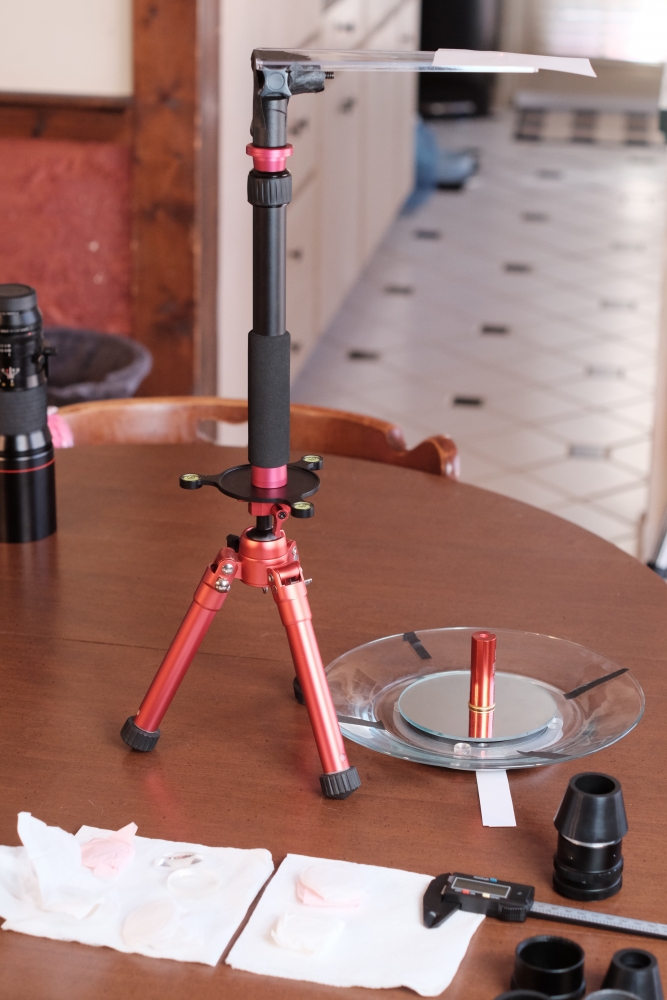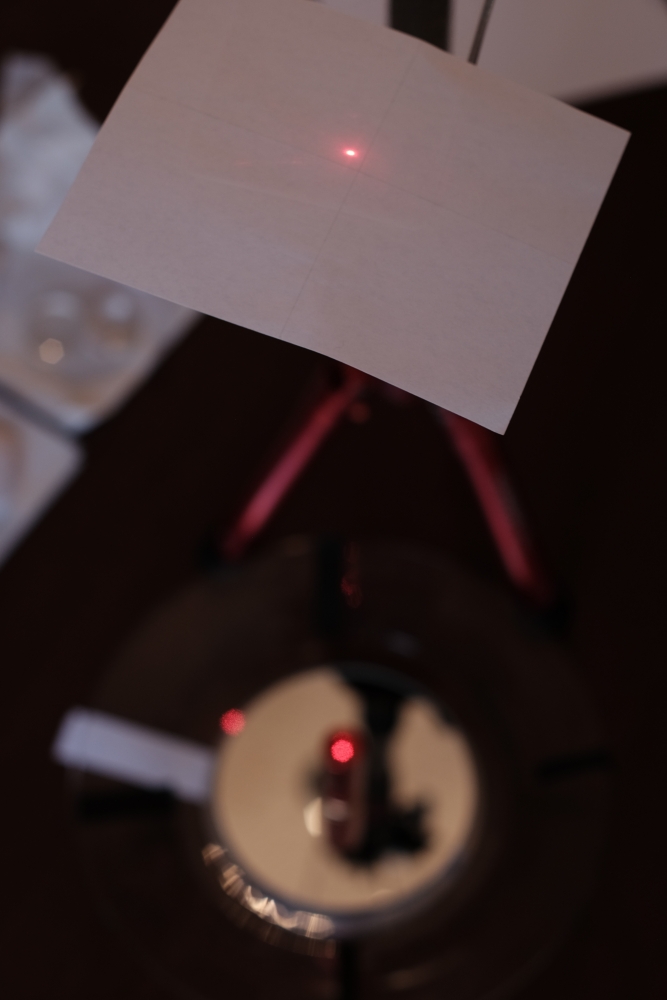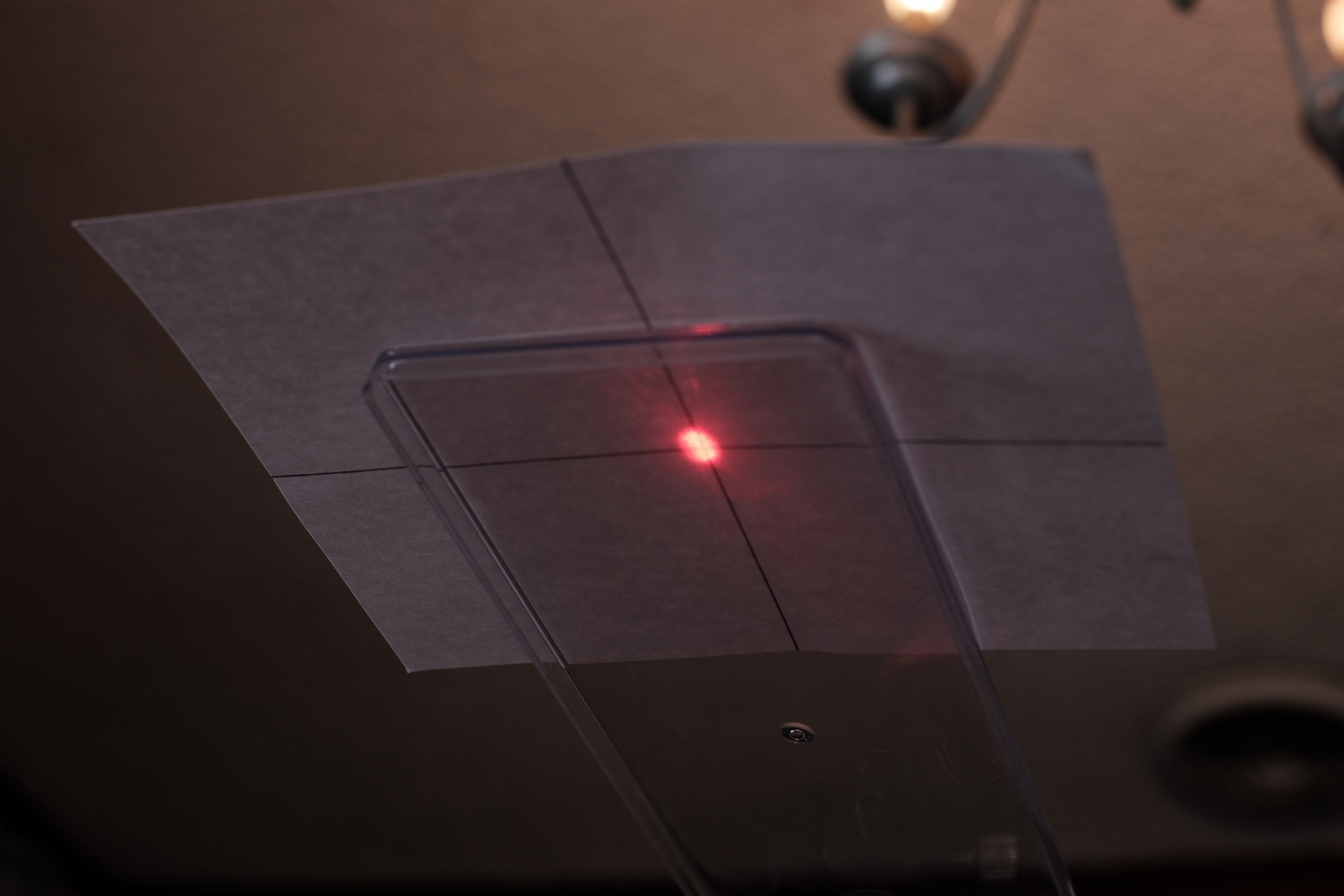| View previous topic :: View next topic |
| Author |
Message |
Paragon19
Joined: 26 Dec 2021
Posts: 45
|
 Posted: Fri Feb 18, 2022 10:17 pm Post subject: DIY Element Alignment Project Posted: Fri Feb 18, 2022 10:17 pm Post subject: DIY Element Alignment Project |
 |
|
Paragon19 wrote:
Now begins the tale of the experiment that spawned preceding experiments. In my quest to acquire the ability to adequately cement lens elements, I realized first that I must journey down the paths of learning both to separate elements, and align elements as well.
Bear in mind as we continue that I have essentially no experience or specialized knowledge in these subjects or skills. To those of you here who actually do have the kind of knowledge and skills this requires, I would love your input. I'd really like to hone a reasonably accessible DIY method for aligning lens elements, and any information or ideas you, or anyone else here have would be greatly appreciated. If you notice me screwing something up, please say so, I fully admit I know very little about what I'm doing.
All that said, the idea is simply to use a laser pointer to locate and align the centers of curvature of the lenses during the cementing process, using a setup a little bit like this:


Today I actually got around to combining all the pieces I accumulated to do a first run, and...it was a failure. That's okay, I expected to need some revision, that's where I'm hoping some of you can help out. Here are the parts assembled so far:

First we have a "heavy duty swivel turntable", a heavy glass plate, and a small mirror.

Next have a laser bore sighter, this one designed for 12-gauge shotguns, some vacuum pad lens tools, and an uncemented achromat doublet (six identical doublets total, actually), sourced from Surplus Shed.
The operation is fairly simple; the laser pointer is put on the turntable in the center, and then a target is suspended above it with some sort of reference mark:


To get the laser centered, the turntable has to be rotated. As it rotates the laser will trace a circle on the target, with a radius the same as the laser's distance from the true center of the turntable. Then the laser is to be gently tapped into place until the rotation is no longer marked by a circular path.
Here, unfortunately, I hit the first stumbling block. For starters, we don't actually have any assurances the laser's path is truly vertical the way it's standing on the plate. The mirror is added to try and provide a level surface, but the laser itself may still be shining at an angle. The first workaround I have planned to account for this is actually to mount the laser pointer on silly putty, or perhaps something a bit stiffer yet still malleable, to allow the angle of the laser to be gently adjusted as well.
Compounding the issue, however, is the turntable itself. For starters, the turntable chosen does not sit or remain completely level, due to the soft feet on both top and bottom. Second, the actual motion of the turntable itself produces a wobble, which makes it hard to tell how well the laser has been centered.
Ideally however, once the laser is centered, a lens element holder is to be placed around the laser, to allow the beam to shine through the lens elements. Each element is then to be gently tapped into place as the turntable is again rotated, until the top and bottom centers of curvature are aligned. Once the first element is aligned, LOCA is to be applied, and then the second element is to be added, and again gently tapped into place until both of it's centers of curvature are aligned as best possible with the lower element.



The previous three images were taken simply as an illustration, and were not properly aligned, but here still you may have noticed the second stumbling block in the way the lenses are supported, and the fact that they are not level, and the extension tubes are also not aligned to keep the laser in the center. Part of the problem is the vacuum pad tool I'm using as a support, instead of something that can attach to the extension tubes integrally. I also found the material kept a bit too much grip on the glass.
So right now I'm looking for ideas for a more suitable turntable with less play and variation, as well as a more suitable support of a small enough diameter to support the lens elements, and soft enough material to avoid damaging the glass, but still allow the element to be shifted as needed for alignment. My current ideas are a small rotary table, and a plastic tube support for the lens elements, something with a heavy and wider base, to prevent toppling and shifting. I'll also need to devise a way to access the laser while the lens holder is still in place.
It's not exactly a lot of progress yet, but again, here I hope I might be able to get some assistance with brainstorming or part sourcing. I'm sure there are some more appropriate components I could be using, and that someone here should have an idea of where I can get them, much the way kds315* pointed me toward Surplus Shed when I asked for doublet sources. Otherwise, more progress to be posted once it has been made. |
|
| Back to top |
|
 |
Paragon19
Joined: 26 Dec 2021
Posts: 45
|
 Posted: Sat Feb 19, 2022 6:53 am Post subject: Posted: Sat Feb 19, 2022 6:53 am Post subject: |
 |
|
Paragon19 wrote:
I just woke up in the middle of the night and had the realization that multiple levels of a translucent material would make it easier to check the the angle of the laser during calibration. I also realize now I'm going to need to construct a base and arm on which to attach the rotary table and reference point target, which should not only help minimize beam movement due to vibration or other sources, but also hopefully decrease re-calibration time and allow me to clamp the alignment station to my work space.
I'll probably sketch a diagram of the idea in the morning. It helps me fall back asleep to put my thoughts down somewhere so I don't need to keep thinking about them, and what better place than this thread? |
|
| Back to top |
|
 |
RokkorDoctor


Joined: 27 Nov 2021
Posts: 1438
Location: Kent, UK
Expire: 2025-05-01
|
 Posted: Sat Feb 19, 2022 2:42 pm Post subject: Posted: Sat Feb 19, 2022 2:42 pm Post subject: |
 |
|
RokkorDoctor wrote:
The theory of a lot of what you are doing is fine; professional setups will have a lot of these elements. 
I admire your courage & perseverance; as you are discovering, a few problems are to be anticipated in the DIY arena:
1) Bearing stability of the rotational platform. This needs to be very accurate. Professional setups often employ air bearings, the lazy-susan ball bearing you are using I very much doubt will be accurate enough for centering purposes. I would suggest you really want less than 10 microns play even for a DIY setup.
2) The whole setup needs extremely good stability. Professional setups employ very stable column mounts, if you are going to have to go the tripod route then do get rid of any rubber feet etc. and use metal spikes on a stable and flat hard surface etc.
3) For centering lenses you will need to collimate the laser output of the doublet to be centered. E.g. if you were to want to center a doublet of negative power, you will need additional optics to re-collimate the laser beam onto the target.
4) Professional setups have high magnifying optics, so the wobble is magnified significantly for both ease of observation as well as aiding quantification of the residual centering error.
5) Once the first lens (say the crown e.g.) has been centered, you will need a way to lock it into position, so that when you tap the flint into position, you are not disturbing the crown lens. I believe professional setups use a vacuum suction process to do this, but I could have that wrong.
Other than the stability issues that you need to address, I think you will also need additional optics to address 3) and 4).
It almost feels as if a microscope frame would be a better base to start from.
Good luck, admire your enthusiasm! 
_________________
Mark
SONY A7S, A7RII + dust-sealed modded Novoflex/Fotodiox/Rayqual MD-NEX adapters
Minolta SR-1, SRT-101/303, XD7/XD11, XGM, X700
Bronica SQAi
Ricoh GX100
Minolta majority of all Rokkor SR/AR/MC/MD models made
Sigma 14mm/3.5 for SR mount
Tamron SP 60B 300mm/2.8 (Adaptall)
Samyang T-S 24mm/3.5 (Nikon mount, DIY converted to SR mount)
Schneider-Kreuznach PC-Super-Angulon 28mm/2.8 (SR mount)
Bronica PS 35/40/50/65/80/110/135/150/180/200/250mm |
|
| Back to top |
|
 |
Paragon19
Joined: 26 Dec 2021
Posts: 45
|
 Posted: Sat Feb 19, 2022 4:49 pm Post subject: Posted: Sat Feb 19, 2022 4:49 pm Post subject: |
 |
|
Paragon19 wrote:
Very useful input, thank you!
| RokkorDoctor wrote: |
| 1) Bearing stability of the rotational platform. This needs to be very accurate. Professional setups often employ air bearings, the lazy-susan ball bearing you are using I very much doubt will be accurate enough for centering purposes. I would suggest you really want less than 10 microns play even for a DIY setup. |
Yes, the lazy-susan turntable has already proven woefully insufficient for this project, it's the first thing I need to replace to make any new progress. Any advice on other sources of rotational platforms would be fantastic. Right now I'm considering some inexpensive milling machine rotary tables with worm gears, though I also have no experience with these.
| RokkorDoctor wrote: |
| 2) The whole setup needs extremely good stability. Professional setups employ very stable column mounts, if you are going to have to go the tripod route then do get rid of any rubber feet etc. and use metal spikes on a stable and flat hard surface etc. |
Honestly I can just do it on the floor or the ground if it comes down to it, I'm not opposed to sitting cross-legged on the floor. Unless you mean the arm holding the reference target above, in which case the tripod was simply the first thing I thought of, not something I feel a need to stick with.
| RokkorDoctor wrote: |
3) For centering lenses you will need to collimate the laser output of the doublet to be centered. E.g. if you were to want to center a doublet of negative power, you will need additional optics to re-collimate the laser beam onto the target.
4) Professional setups have high magnifying optics, so the wobble is magnified significantly for both ease of observation as well as aiding quantification of the residual centering error. |
Very good to know. Possibly something Surplus Shed can help with, or perhaps some of my lenses that are beyond repair. This is exactly why I mentioned I have no experience with this kind of thing, it would have probably taken me awhile to understand I was missing this.
| RokkorDoctor wrote: |
| 5) Once the first lens (say the crown e.g.) has been centered, you will need a way to lock it into position, so that when you tap the flint into position, you are not disturbing the crown lens. I believe professional setups use a vacuum suction process to do this, but I could have that wrong. |
I actually was aware professional setups use vacuum suction for this, thanks to a demonstration video I saw. My initial reaction was to simply expect I wouldn't be able to utilize anything like this, but after a little thought, a hand vacuum pump might work for this purpose. Perhaps if I seal the bottom of the element holder above the laser pointer with a piece of glass and some epoxy. This narrows the search for an element holder down to something with a valve to which I can attach the hand pump with some vinyl tubing. The trick is attaching the pump to the tubing without disturbing the first element after it's aligned, since it would be hard to leave it attached while rotating. I could easily leave the vinyl tubing attached though, hanging off the side of the rotational platform, as long as it doesn't strike anything during rotation that might cause vibration.
| RokkorDoctor wrote: |
Other than the stability issues that you need to address, I think you will also need additional optics to address 3) and 4).
It almost feels as if a microscope frame would be a better base to start from. |
This is a very interesting idea, I assume you mean as a platform for the elements and a method of collimating and magnifying the beam?
| RokkorDoctor wrote: |
Good luck, admire your enthusiasm!  |
Thanks! I think something I need to figure out before I proceed further is what kind of precision is acceptable to me for this project. The obvious answer is probably, "close to the precision used to first assemble the lenses I want to repair", and ideally just as or more precise than was used, if possible within my budget and means. So my next step will be research on determining what kind of precision was used for camera lens alignment of previous eras.
It sounds like you have professional experience, do you mind sharing the background of your experience? |
|
| Back to top |
|
 |
RokkorDoctor


Joined: 27 Nov 2021
Posts: 1438
Location: Kent, UK
Expire: 2025-05-01
|
 Posted: Sun Feb 20, 2022 12:32 pm Post subject: Posted: Sun Feb 20, 2022 12:32 pm Post subject: |
 |
|
RokkorDoctor wrote:
| Paragon19 wrote: |
It sounds like you have professional experience, do you mind sharing the background of your experience? |
No professional experience I'm afraid. Just years of hobby work on the servicing of lenses (mostly) and cameras (a bit).
I did decide to bite the bullet and invest in a number of books about the design, manufacture and mounting of lenses. Whilst there is a lot of information available throughout the various forums on the internet, it was never clear to me what is fact and what is myth, and to what degree there was any scaremongering re. centering, degrees of precision etc.
Getting a few "insider" books that deal with both the history and current state of affairs re. these procedures, together with some service manuals, at least now I have a better understanding of what tolerances would have typically been applied during the various construction & assembly stages.
Unfortunately, these books are bit of a niche market, hence they are surprisingly expensive 
Some examples:
General:
A History of the Photographic Lens, Rudolf Kingslake, Academic Press, 1989
Optics in Photography, Rudolf Kingslake, SPIE Optical Engineering Press, 1992
Applied Photographic Optics, Third Edition, Sidney F. Ray, Focal Press, 2002
Lens Design:
Lens Design Fundamentals, Second Edition, Rudolf Kingslake, R. Barry Johnson, Academic Press, 2010
Lens Manufacturing:
Prism And Lens Making, Second Edition, F. Twyman, CRC Press, 1952, 1988
Fabrication Methods for Precision Optics, Hank H. Karow, Wiley-Interscience, 2004
Optics Manufacturing, Christoph Gerhard, CRC Press, 2018
Mounting Optics in Optical Instruments, Second Edition, Paul R. Yoder Jr., SPIE Press, 2008
Factory Service Manuals for:
Minolta cameras: SRT, XE, XD7/XD11, XG7, XG2, XGE, XG1, XGM, X300/X370, X700
Lenses (some full service manuals, some parts diagrams): Minolta Rokkor MC 7.5mm f/4, MC 16mm f/2.8, MC 17mm f/4, MC 24mm f/2.8, MC 28mm f/2, MC 28mm f/2.5, MC 28mm f/2.8, MC 28mm f/3.5, MC 35mm f/1.8, MC 35mm f/2.8, MC 50mm f/1.7, MC 50mm f/1.4, MC 50mm f/3.5 Macro, MC 100mm f/2.5, MC 100mm f/3.5 Macro, MC 135mm f/2.8, MC 135mm f/3.5, MC 200mm f/3.5, MC 300mm f/4.5, MC 300mm f/5.6, MC 400mm f/5.6 APO, MC 80-200mm f/4.5, MC 100-200mm f/5.6
_________________
Mark
SONY A7S, A7RII + dust-sealed modded Novoflex/Fotodiox/Rayqual MD-NEX adapters
Minolta SR-1, SRT-101/303, XD7/XD11, XGM, X700
Bronica SQAi
Ricoh GX100
Minolta majority of all Rokkor SR/AR/MC/MD models made
Sigma 14mm/3.5 for SR mount
Tamron SP 60B 300mm/2.8 (Adaptall)
Samyang T-S 24mm/3.5 (Nikon mount, DIY converted to SR mount)
Schneider-Kreuznach PC-Super-Angulon 28mm/2.8 (SR mount)
Bronica PS 35/40/50/65/80/110/135/150/180/200/250mm |
|
| Back to top |
|
 |
|
|
|
You cannot post new topics in this forum
You cannot reply to topics in this forum
You cannot edit your posts in this forum
You cannot delete your posts in this forum
You cannot vote in polls in this forum
|
